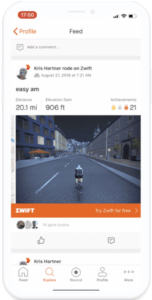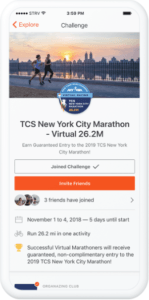Strava: Out Running the Competition?

Founded in 2009 as an app for only the most serious athletes, Strava has grown to become the number one app for runners and cyclists by building a multi-sided fitness platform.
Strava’s Value Proposition
Strava is a growing fitness platform that claims to be “the home for your active life” and although they don’t publish their total user count, they have been adding a million users every 45 days while continuing to build out new features.[1] The freemium platform allows athletes to track, upload, share, compete, and build a community around fitness. This functionality creates tremendous value for athletes, both casual and professional, as well as brands who connect and advertise on the program, and finally for the ecosystem of other fitness apps that use Strava as a central platform. Strava has become the hub for a wide range of players in the fitness space from data import and analysis companies (Garmin, Fitbit, Tom Tom), to gyms (Flywheel, Peleton), to virtual reality fitness apps (Zwift), and many more.[2]
Elements of the Platform
Strava Labs
Strava acts as a platform that amalgamates data across many different devices and apps, but what is truly innovative is that they continue to utilize this growing dataset to build new features. Strava Labs is Strava’s innovation division focused specifically on supporting developers and building prototype features for their userbase to test. Developers are encouraged to experiment with Strava’s APIs and rich dataset to identify future full-fledged features. One recent introduction of Strava Labs is Flyby, a feature where runners and cyclists can look over a past workout and see the other users they passed by on the trail and connect with them on Strava. Although this feature struggled initially with sufficient privacy controls, it has the power to make friendly faces on a run into digital workout buddies, and create a community around what is often an individual sport.[3]

Strava offers brands multiple innovative advertising opportunities to connect with target customers in unobtrusive ways. For example, other fitness products, such as Zwift’s VR biking application, can utilize sponsored integration where an athlete shares a screenshot of their workout with a banner link allowing their followers to learn more about the app they use in training. This offers authentic sponsorship as well as reinforces Strava as the common platform to share workouts across all ecosystems. Similarly, brands such as Lululemon and New York Road Runners can sponsor challenges and workout clubs such as the Lululemon “Ghost Race” or the Virtual NYC Marathon where users can compete from anywhere in the world simply by uploading their data to the Strava platform. This enables the brand to build awareness and a community while giving Strava an additional revenue stream.



Data and Dating
A final unique aspect of the Strava platform is that they have successfully created both a data collection and analysis platform as well as a social network specifically for athletes. Strava has become a Facebook for like-minded people, with some users even finding love on the app.[8] Strava has capitalized on this aspect of the platform, understanding its potential to make the platform stickier and even appointing a former executive from Instagram, James Qualres, as CEO. Strava must continue to bridge the widening gap here, ensuring they keep their hardcore athletes happy while supporting the social media aspects that create a strong community on the platform.
Strava’s Revenue Model
The potential for value creation through Strava is immense, especially as it’s base of athletes, brands, and partner applications continues to grow. Their freemium model with additional advertising revenue give Strava the potential to capture a significant amount of this value, but also require careful consideration into price and product to avoid losing their most critical asset – the athletes.
Sources
[1] Goode, Lauren. “Fitness App Strava Really, Really Wants to Be the Social Network for Athletes.” The Verge, 2 May 2017, www.theverge.com/2017/5/2/15511118/strava-fitness-tracking-app-athlete-posts-social-network.
[2] “Strava Apps.” Strava, 2019, www.strava.com/apps.
[3] Robertson, Andy. “’Strava Flyby’ Connects Runners But Unexpectedly Exposes Run Data.” Forbes, Forbes Magazine, 19 May 2015, www.forbes.com/sites/andyrobertson/2015/05/19/strava-flyby/#371f71572356.
[4] “Strava Activity Playback.” Strava Labs, www.labs.strava.com/flyby/.
[5] “Strava Case Study: Zwift – Grow Your Brand with Strava Business.” NYRR : Strava Business Case Study, www.business.strava.com/cases/zwift.
[6] “Strava Case Study: NYRR – Grow Your Brand with Strava Business.” NYRR : Strava Business Case Study, www.business.strava.com/cases/nyrr.
[7] “Strava Case Study: Lululemon – Grow Your Brand with Strava Business.” NYRR : Strava Business Case Study, www.business.strava.com/cases/lululemon.
[8] Vernasco, Lucy. “Finding Love on Strava.” Outside Online, Outside Magazine, 16 Nov. 2016, www.outsideonline.com/2055581/finding-love-strava.
[9] “Social Fitness Platform Strava Introduces New Subscription Model.” SportTechie, 1 Aug. 2018, www.sporttechie.com/social-fitness-platform-strava-introduces-new-subscription-model-summit/.
[10] “Features for Athletes, Made by Athletes.” Strava, www.strava.com/features.
[11] Quarles, James. “A Letter to the Strava Community.” Strava, 29 Jan. 2018, www.blog.strava.com/press/a-letter-to-the-strava-community/.



I can’t believe I have never heard of this app before. The ability to have a ‘leader board’ reminds me a lot of the Crossfit Open where people post their workout times and score how they ranked against their peer group.
The Flyby feature was a little creepy for me, as I could see how nefarious actors might abuse the system. Also, the data tracking reminded me of a recent security incident where sensitive US Military installations where highlighted by Strava data.
Thank you for sharing!
https://www.theguardian.com/world/2018/jan/28/fitness-tracking-app-gives-away-location-of-secret-us-army-bases
So true, Jose! Turns out a lot of users agreed with you, especially following the unfortunate Military incident. It seems like privacy is one place where Strava (and many other platforms) still has a ways to go, while the functionality to turn off location sharing already exists I think the ease of use and “opt-in” nature could be greatly improved.
Thanks for sharing this! I am curious about other paths for growth and monetization. I like the “subtle advertising” approach, but I wonder if they can move into the adjacent market of “content creation.” Imagine an “Instagram for Athletes,” by Strava: it would look, feel, and act just like Instagram, but would be built by Strava, and geared solely for sharing content & experiences with your community.
As I think about how the crowdsourced content space emerges, I think that this the “kitchen sink” approach that Instagram takes may give way to a half dozen platforms that have distinct social networks and cohesive aspects (i.e. your professional sphere, your fitness sphere, your home sphere, etc.). If this is how the industry shapes up, then Strava could actually have a high-margin programmatic ad business, which would supplement its current model.
What a great platform! But it looks like Jose beat me to the punch…as with any platform such as Strava, that shares positional data of its users, there needs to be additional education to the users about what the potential side-effects are. However, I do not feel this is solely Strava’s responsibility. In the case of the data being used to show potential locations of military bases, this highlights the risk of what can be revealed when data that appears to be harmless is put together with other user’s data. The security implication doesn’t apply only to military bases, but also the average user. As people post data over time, a nefarious actor could easily develop a pattern of life for a user and pursue less than honorable intentions.
This is so cool! Thanks for sharing this. Can really see the value add. Used to use MayMyRun but it didn’t add a lot of value for me. I really like the social aspect to this as well.